
Regular eye exams are essential for people with diabetes and are key to safeguarding their vision. Diabetes increases the risk of developing eye conditions such as cataracts, glaucoma, and diabetic retinopathy.
The Center for Disease Control and Prevention indicates that almost one-third of adults with diabetes suffer from diabetic retinopathy. The disease is one of the leading causes of low vision and blindness in the country.
Understanding Diabetic Retinopathy
Diabetic retinopathy is a term that describes retina disorders resulting from diabetes. There are two main types of retinopathies; non-proliferative and proliferative retinopathy. Non-proliferative retinopathy is the more common type characterized by increased blood sugar levels in diabetic individuals.
It causes damage to the retina blood vessels, the eye area responsible for capturing and sending images to the brain. Damage or blockage to the blood vessels can cause fluid and blood leakage into the macula. It is the part of the eye responsible for focusing.
Progression of Diabetic Retinopathy
Proliferative Retinopathy occurs when the condition progresses to a more severe form. The blood vessels are severely damaged, and they close off. It causes new blood vessels to start growing in the retinal tissues.
The new vessels are weak and susceptible to leaking, which can block vision, a condition known as vitreous hemorrhage. The vessels can lead to the growth of scar tissue that can shrink, distorting the retina and pulling it out of place. It is known as retinal detachment.
Symptoms of Diabetic Retinopathy
Diabetic retinopathy has few symptoms in the early stages. Most people experience minor vision issues that are often attributed to other reasons. Anyone with diabetes can develop retinopathy. Symptoms include:
Fluctuating vision.
Dark or empty areas in the line of vision.
Reduced color vision.
Dark spots (floaters) or strings in the vision.
Loss of vision.
Importance of Early Detection
Most people with diabetes are unaware that they have retinopathy due to the lack of symptoms. Regular eye exams can help to prevent loss of vision. Dilated eye exams allow eye doctors to view the back of the eye, which can help with disease detection.
Early detection will enable people with Type 1 and Type 2 diabetes to benefit from available treatments. Doctors recommend follow-up exams depending on the individual’s risk.
Treating Diabetic Retinopathy
Advances in technology have improved the ability to treat retinopathy. Studies show that Laser Photocoagulation can help to slow vision loss from the disease. Injections of anti-vascular endothelial growth factor (VEGF) can reduce vision impairment resulting from diabetic macular edema.
Imaging technology can help to measure swelling of the retinal tissue. It improves the eye doctor’s ability to monitor the condition and adjust treatment as necessary. Effective treatment is dependent on detecting the disease in the early stages.
The risk of developing diabetic retinopathy increases when an individual has had diabetes for long. Failing to treat diabetic retinopathy can lead to complications such as:
Vitreous hemorrhage.
Retinal detachment.
Glaucoma.
Blindness.
Regular eye exams are the best way to protect vision and eye health.
For more on the importance of early detection and treatment for diabetic retinopathy, visit Gulf Coast Vision at our office in Gulfport, Mississippi. Call (228) 262-0266 to book an appointment today.








